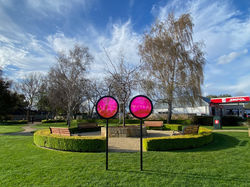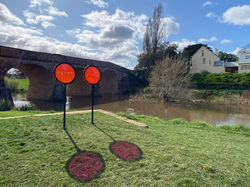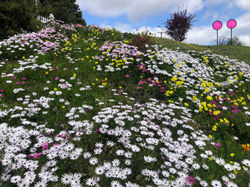 |  |  |  |  |
|---|---|---|---|---|
 |  |  |
BLIND SIGHT 2024
Blind Sight consists of pairs of fluoro pink lenses installed in three key locations in the historic village of Richmond, Tasmania to mark its bicentenary. The lenses are engraved with braille that spells the words blind and sight, a term that refers to the uncanny ability of someone with no cortical vision to detect and respond to visual stimuli despite being unable to see. I was interested in how the simultaneous occurrence of vision and blindness might apply to the experience of visiting, or living in Richmond.
Richmond is a beautiful village. It is surrounded by vineyards, sheep and fruit farms, and is well-known for its fine examples of both grand and modest colonial architecture. The main road is lined with quaint shops where you can buy antiques, art, craft and lavender, enjoy a Devonshire tea, or have a meal in the award-winning sandstone pub. There is a maze, a meticulously engineered scale model of 1830s Hobart Town, a village green with a worker’s cottage that sells gingerbread, a lolly shop, a catholic church and an Anglican church, both historically significant, and a convict gaol that precedes Port Arthur. Perhaps most notably, Richmond is the site of the oldest stone bridge in Australia. It crosses the Coal River, where you can picnic along the grassy banks and feed the many ducks that live there.
Richmond. One of the most popular and beloved tourist destinations in southern Tasmania. You would be forgiven for thinking you had arrived in the film set for a cosy English murder mystery.
And in a sense, you have. Because beneath its charming façade, Richmond has a dark and confronting past. It is the land of the Mumiruminer people who regularly held vast communal gatherings in the area. None have survived, slaughtered by their colonial occupiers, and their stories remain largely under-acknowledged. Parallel to this tragedy, hundreds of men and women were incarcerated in the Richmond gaol, often for petty crimes, and the village itself was built using slave labour. Richmond. Beautiful on the surface, but with a grim and challenging underbelly.
Blind Sight aims to question how Richmond is perceived today. It cannot uncover its difficult past, but by using braille, glass lenses and the colour pink, it can propose that our perception of this charming village is distorted by viewing it through rose coloured glasses.
Details
Blind sight, 2024
Steel, perspex, braille
Installed in three sites: Richmond Bridge, Richmond Village Square, outside St Luke's Anglican Church.
Site: Richmond: Something in the exchange
Exhibition celebrating the Richmond
Bicentennary.
Featured artists: Eloise Daintree, Selena de Carvahlo, George Kennedy, Amber Koroluk-Stephenson, Mary Scott, Nunami Sculthorpe-Green, Brigita Ozolins, Angus Thornett
A Clarence City Council Arts Event funded by Arts Tasmania
With special thanks to Stuart Houghton for construction of steel frames and Associated Plastics for fabricating the lenses.
Image credits: Brigita Ozolins
Image with flowers: Lisa Ker